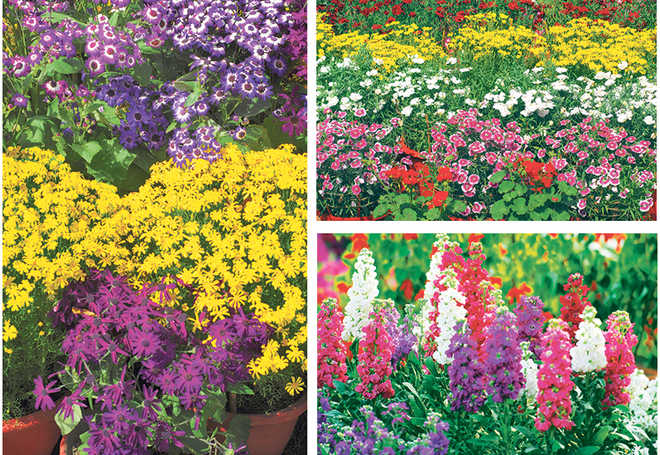It’s time to plant winter annuals
Amarjeet Singh Batth
Winter annuals offer the widest range of choices of flowers in form, shapes and colours. The real vibrancy comes in spring when flowers deck the flowerbeds, pots and hanging baskets create a floral bonanza. Winter annuals are spaced between trees, shrubs and lawn. An aesthetically planned garden with good colour scheme, planted in harmony or in contrast at various levels, is a visual delight.
When to plant
As rains recede, humidity level goes down and night temperature falls, it’s time to sow seeds of winter annuals starting from end September, which are transplanted in the flowerbeds in October-November to bloom in February-March.
Finding the right space
Location, sunlight and available of space primarily determine the choice of flower, followed by the purpose for which these are planted like for screening, as a background, in a flowerbed, at an edge, along a path, etc.
Getting started
Use only branded seeds and purchase seedlings from good nurseries only. Petunia, pansy, marigold, phlox, alyssum, dahlia, dianthus, salvia, calendula, larkspur, antirrhinum, lupin, candytuft, wall flower, verbena and stocks, etc. are popular.
Time to sow
Raised nursery beds about 15-20 cm high and 60-90 cm wide are prepared under partial sunlight. A nursery medium is prepared by taking: one part of soil, one part of river sand, one part of well-rotten farmyard manure, one part of leaf mould and passed through a wire mesh to break the lumps. Drench the nursery medium with 0.2 per cent bavistin to take care of soil-borne diseases. Moist the nursery beds before sowing the seeds. These must be sown in lines 4-6 cm apart at a depth of 0.5 -1 cm depending on the seed size. Sprinkle the nursery bed immediately with a mist of water using hand spray pump. To prevent the ants apply chloropyrofos 20 EC. Cover the bed with a newspaper or sarkanda and keep the soil moist by regular misting till the seeds germinate within two weeks. Seedlings on germination appear to be crowded and make weak seedlings, thinning of the seedling lumps can be done at this stage and replanted them where there is space around. Seedlings are ready for transplanting when three to four pair of leaves appears.
Harding of seedlings
Seedlings must be hardened off before transplanting by withholding water and exposure to sun. Transplantation should be done during evening hours using a khurpe with a narrow blade to loosen the soil near the base and gently pull the seedling. Ensure that the soil around the delicate roots remains attached. Immediately transfer the seedlings into the flowerbeds and irrigate.
Prepare the flowerbeds
The flowerbed should levelled with good drainage and weed free. Add six to seven baskets (or 5 to 6 kg) of well-decomposed farmyard manure and add DAP 500 gm in a hundred square feet area (10’X10’). Mix the ingredients thoroughly. The soil bed is now prepared and ready for transplantation.
Follow colour scheme
A gardener must be familiar with the colour wheel. White colour flowers highlight the colours of accompanying flowers. Different kinds of flowers are grown highlighting other colour in a mix flowerbed. Seasonal flowers give impressive display when planted against a green herbaceous border.
Synchronise smartly
Take care that the flowers must bloom at the same time, and for almost the same period, else there will be dry and ugly patches in your flowerbeds.
Follow the sequence
Three flowering layers can be formed if the flowerbed width allows. Tall plants like antirrhinum, coreopsis, holly hock and larkspur in the background and medium-sized calendula, lupin, marigold and sweet sultan in the middle followed by alyssum candytuft (white), ice plant (mix or single colour) and matricaria. If the garden area is large, fill it with large-sized impressive flowerbeds of petunia, antirrhinum, phlox, verbina. Petunia, salvia makes a good combination. Shade-loving plants like salvia, cineraria or begoia will liven up a dull area.
Finding the right flower
Screening: Holly hock, Lady’s lace
Background: Sweet Pea, Corn Flower, Larkspur
Border: Antirrhinum, Corn Flower, Helichryson
Flowerbed: Acroclinum, antirrhinum, kale, brachycome, calendula, China aster, sweet sultan, wall flower, cosmos, dahlia, sweet William, dimor, California poppy, gerbera, gypsophila, lupin, stock, nemesia, petunia, salvia, cineraria, African marigold, French marigold, nasturtium.
Edging: Antirrhinum dwarf varieties, brachycome, pink, candytuft, sweet alyssum, ice plant, verbena, pansy.
Pots: Bellis perennis, brachycome, pansy, kale, dahlia, sweet William, carnation, pink, matricaria, gazania, lupin, ice plant, nemesia, petunia, salvia, cineraria, nasturtium, pansy.
Window boxes: Calendula, geranium, petunia, phlox, nasturtium, verbena, pansy.
Fragrance: Wall flower, sweet sultan, alyssum, antirrhinum, petunia, stock, sweet peas
Flower arrangements: Acroclinium roseum (paper flower), ammi majus, pimpinella monoica (lady’s lace), amobium alatum, antirrhinum majus (dog flower or snap dragon), calendula officinalis (pot marigold or gulsarf), callistephus chinensis (aster), centaurea cyanus (corn flower), delphinium ajacis (larkspur), gerbera jamesonii, dianthius caryophyllus (carnation), dianthius barbatus (sweet William), gypsophila, helichrysum, iberis amara (candytuft), mathhiola incana (stock), molucella laevis (bells of Ireland).









